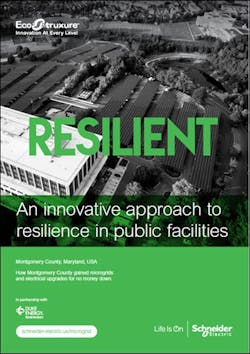Montgomery County Microgrid Project Highlighted in New Schneider Electric Report
Upfront cost can be a barrier to microgrids. But what if you could have a microgrid project and electrical upgrades for no money down? A new report from Schneider Electric explores this accomplishment at government facilities in Montgomery County, Md., energy-as-a-a-service arrangement and innovative power purchase agreement.
Get the full report.
Montgomery County’s government presence is large, with 9,000 employees and 400 buildings totaling 9 million square feet. And according to the Schneider report, the municipality had an “equally sizable” challenge.
Montgomery County has been a “clean energy leader” for years, the report points out. For example, in 2017, the county set a goal of an 80% reduction in greenhouse gasses by 2027 and a 100% reduction by 2035. But after a large storm caused widespread power outages, Montgomery County was on a mission to help mitigate the potential impact from future natural disasters.
The goal? Increase resilience, upgrade electrical infrastructure, and enhance sustainability — without upfront capital investment. The solution the town came to was to install microgrids at two critical county facilities, ultimately choosing Schneider Electric as its partner.
Schneider Electric notes in the report that this partnership, and project, “pioneered a microgrid model others can follow.” Why? There was no upfront cost, the project incorporated other repairs and upgrades beyond the microgrids, and ultimately, it improved efficiency and ramped up sustainability for the county bordering Washington, D.C.
The report outlines in detail the specifications and process of the project and partnership. The microgrid project at Montgomery County’s Public Safety Headquarters, the municipality’s largest building, included electrical distribution equipment upgrades, 2 MW solar, energy management with a building automation system, and combined heat and power.
“Montgomery County set out to solve its problems involving energy resilience and an aging electrical infrastructure. But what the forward-thinking county achieved has implications far beyond its own borders. It has offered up a model that could bring microgrid benefits to many other communities nationwide. — Schneider Electric”
The two microgrids, and other upgrades to critical facilities, worked to improve the county’s resilience, and will help provide necessary services — even in the event of prolonged power outages.
Get the full report,“An Innovative Approach to Resilience in Public Facilities,” courtesy of Schneider Electric, which explores how Montgomery County increased resilience, upgraded electrical infrastructure and enhanced sustainability by installing microgrids at two of its critical county facilities.







